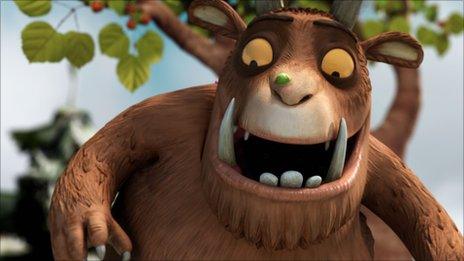Who would love a Gruffalo?
- Published

There's no such thing as a... children's book without a sub-text
The Gruffalo is the favourite book of children and parents alike, according to a survey. For a book which was first published just 11 years ago, it has won a cherished place on the nation's bookshelves. So why does it strike such a chord?
Life can be scary, life can be dangerous. All sorts of threats lie in wait for you, even if you have done nothing wrong. Should you manage to get yourself out of one dangerous spot, another worse one might be in store for you. And that most frightening thing you can possibly think of? It might come true.
At first sight this might seem to be unlikely territory for a modern classic for the under-fives, though perhaps better suited to a cautionary tale about veering from the path. But this is no moral warning: Julia Donaldson's mouse, the central character of the Gruffalo, doesn't do anything to attract his increasingly sinister predators. He is what he is - potential dinner.
The mouse, for anyone who hasn't had the chance to enter his world of terror, walks through a wood. In turn a fox, then an owl and then a snake, all entreat him to join them for something to eat, rather in the way that Hannibal Lecter might.
Dinner guests
Nasty, dissembling creatures, who are only dissuaded from using force by the threat of something bigger and nastier than them, in the form of the creature the mouse makes up on the spot as the worst his imagination can muster.
The mouse, he says, is about to meet this beast, complete with its poisonous warts, terrible teeth, turned-out toes, orange eyes, black tongue, purple prickles on his back; the dreadful, terrifying and - as far as the mouse is concerned, utterly fictional - Gruffalo.
His putative dining companions flee at the thought of something much grimmer than them. Sighing with relief, the mouse figures that the forest isn't so scary after all.
But then he stumbles on a real-life actual Gruffalo, as ugly and as hungry as he imagined. Clutching at the only straw left for him, the mouse convinces the Gruffalo that he, the mouse, is the "scariest creature in this wood", and takes him to meet the fox and others.
Their subsequent fear is of the Gruffalo, but the mouse convinces the beast that it's he, the rodent, they are scared of. The Gruffalo swallows the notion and concludes that he too has something to fear.
He flees, leaving the mouse in the role so familiar to children's stories - the victorious underdog.
Second helpings
Children find their own aspects of the story to be fascinated by. And adults, faced with nightly demands for repeated readings, have no shortage of ways of seeing the inner depths of the tale.
It's about courage and overcoming bullies. Or it's about the nature of fear, where even the most powerful can feel scared. Or it's a story about the power of spin, PR and chutzpah. Or it's a story about the brutal nature of a dog-eat-dog society. Or, even, a radical vegetarian manifesto.
And yet most satisfyingly it's a tale of human manners. The key realisation for the mouse is not the existence of threats, but that his wits can save him.
Thinking more quickly than the others, reacting to their misunderstandings, he pulls an almighty confidence trick. The Gruffalo falls for it, and believes that he could end up in a crumble, lunch for a mere rodent.
In one way, the Gruffalo is not wrong. This little mouse, the smallest and least powerful of all the creatures, but whose wits are sharpening by the minute, is indeed a force to be reckoned with.
And it's there that the parent truly meets their child.